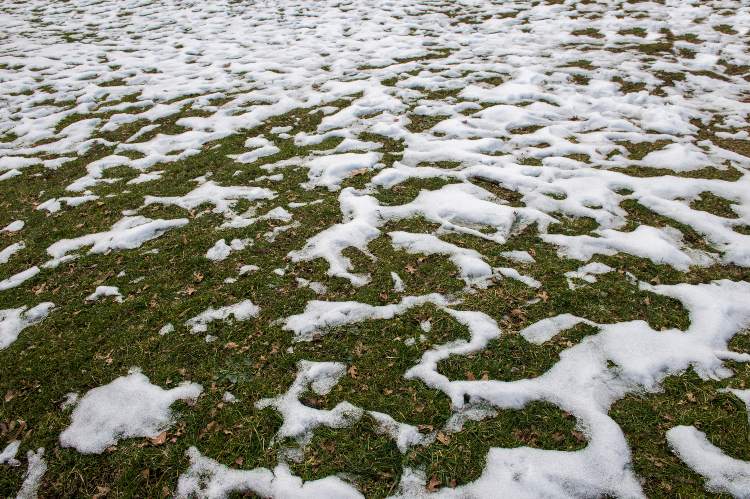Tips To Get a Green Lawn After Winter

The transition from winter to spring brings with it the task of restoring your lawn to its lush, green state. After months of cold weather and possible snow cover, your lawn might look a little worse for wear. But with a few straightforward steps, you can encourage your lawn to become a vibrant green space that enhances your home’s curb appeal. Here’s how to go about it:
Clear the Yard of Any Winter Debris
Starting with a clean slate is essential for the health of your lawn. Winter can leave behind a layer of debris, including leaves, twigs, and even trash, that can suffocate the grass and foster disease. By removing these materials, you ensure that sunlight, air, and water can effectively reach the soil and roots of your grass, which will help keep your lawn growing and healthy.
Cover Any Exposed Areas in Your Lawn With Fresh Seed
Bare spots in your lawn can occur for various reasons, including heavy foot traffic or snow damage. These areas are not only unsightly but can also lead to weed problems. Seeding these spots with fresh grass seed can help to integrate them back into the rest of the lawn, promoting a uniform look. Choose a seed type that matches your existing lawn and follow the seeding instructions for the best results.
Turn on the High Mowing Settings
As your lawn begins to grow, resist the temptation to cut it too short. Setting your mower to a higher setting encourages the growth of strong, healthy grass. Taller grass blades shade the soil, which helps to retain moisture and suppress weed growth. They also promote deeper root development, which is beneficial for the overall health and drought resistance of your lawn.
Make Use of Good Fertilizer
Fertilizing your lawn in the spring provides the grass with essential nutrients needed for growth. However, the type of fertilizer you use and how you apply it can make a significant difference. Look for a fertilizer that is appropriate for your lawn’s specific needs and the current season. Applying it according to the manufacturer’s instructions will help to ensure that your grass receives the right amount of nutrients without the risk of burning or damage.
Water During Appropriate Times of Day
Watering your lawn is most effective in the early morning or late afternoon when temperatures are cooler. This timing reduces water evaporation and ensures that the water penetrates deep into the soil, reaching the roots of the grass. Avoid watering in the evening, as this can leave the lawn damp overnight, increasing the risk of fungal diseases.
The amount of water your lawn needs can vary widely based on factors such as the type of grass, soil, climate, and current weather conditions. However, a general guideline is that lawns typically require about 1 to 1.5 inches of water per week, either from rainfall or irrigation. This amount helps to ensure that the water penetrates deeply into the soil, reaching the root zone of the grass, which encourages deep root growth and helps the lawn to be more drought-resistant.
To achieve deep watering, it’s better to water less frequently but more deeply. For example, instead of watering a little bit every day, it’s more beneficial to water once or twice a week, allowing the soil to receive a good soaking. This method encourages the roots to grow deeper into the soil, seeking moisture, which strengthens the lawn.
You can measure how much water your lawn is getting from irrigation by placing several empty cans (like tuna or cat food cans) around your lawn and checking how much water collects in them after each watering session. Adjust your watering schedule accordingly to ensure your lawn receives the right amount of water.
Remember, over-watering can be just as detrimental to your lawn as under-watering. It can lead to shallow root systems, disease, and fungus. Therefore, it’s also important to consider the weather (recent rains or dry spells) and adjust your watering accordingly. During cooler or rainy periods, you may need to water less, while in hot, dry conditions, your lawn may require more frequent watering.
By following these steps, you can help your lawn recover from the winter and thrive in the warmer months. Regular maintenance and care will keep your lawn looking its best, providing a beautiful and inviting outdoor space for you and your family to enjoy.
Revive Your Lawn With Black’s Lawn and Junk Today!
Black’s Lawn & Junk has been in business for over 10 years, installing, renovating, and maintaining commercial and residential landscaping throughout Weber, Davis, and Box Elder Counties. We bring our expertise to every job we do, big or small. Whether you need help with your yard’s maintenance, sprinkler repair, landscaping, junk removal, or just have some questions, our professionals are ready to help you. Contact us today and let Black’s Lawn & Junk help give you the lawn of your dreams.
